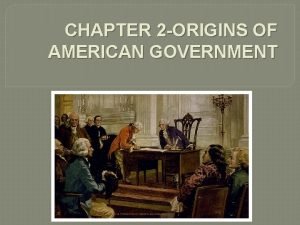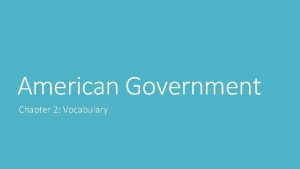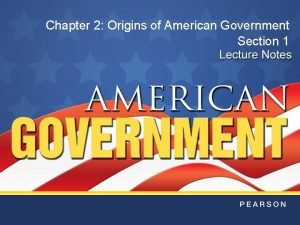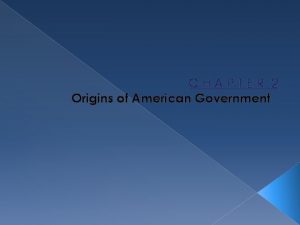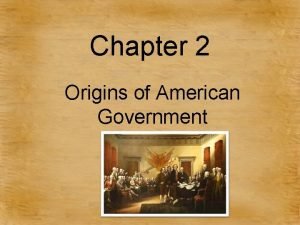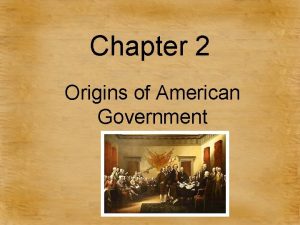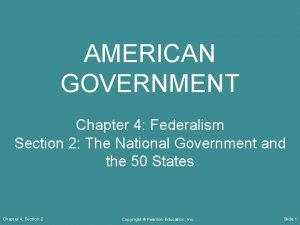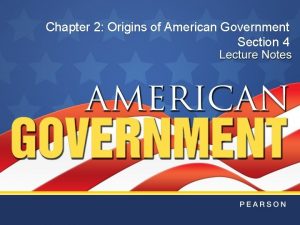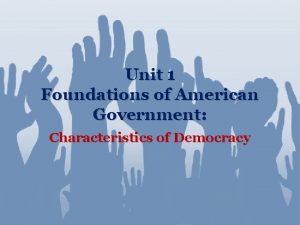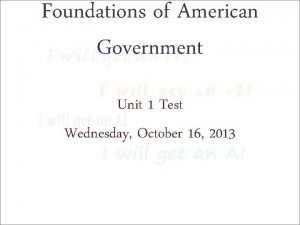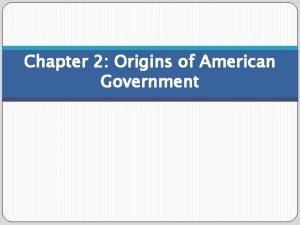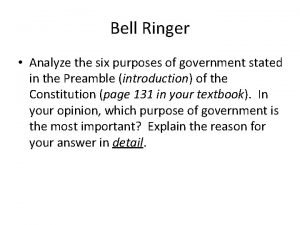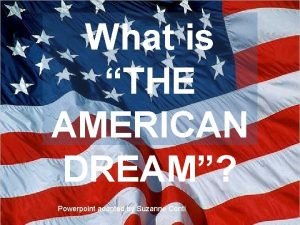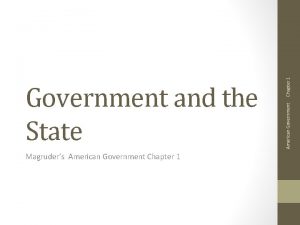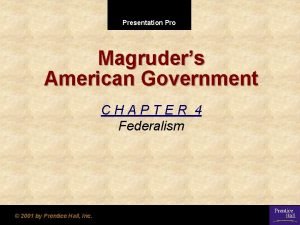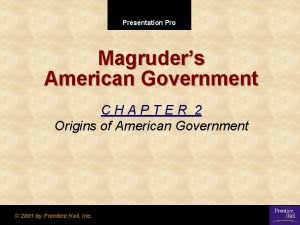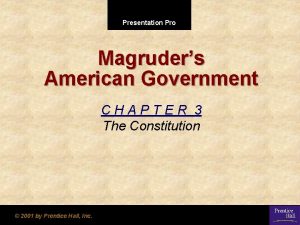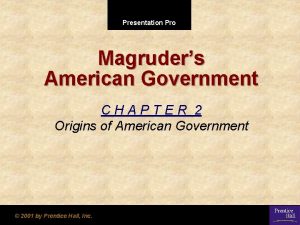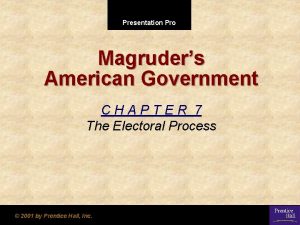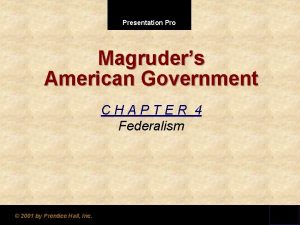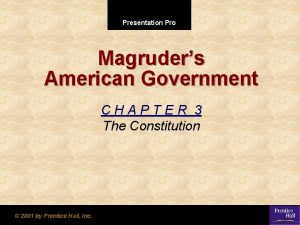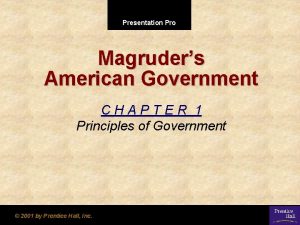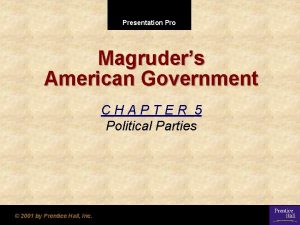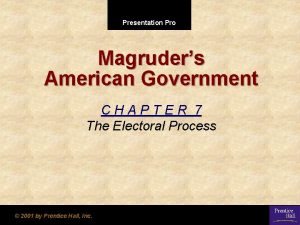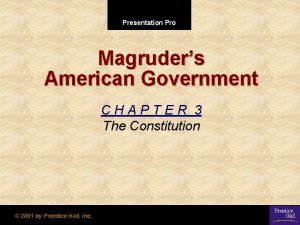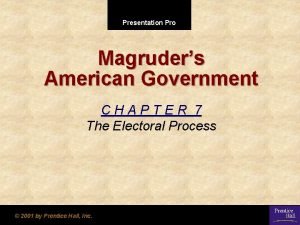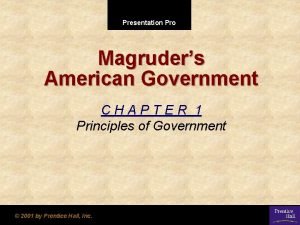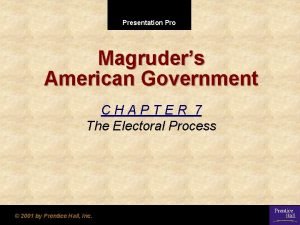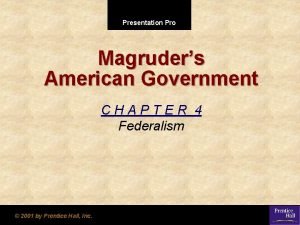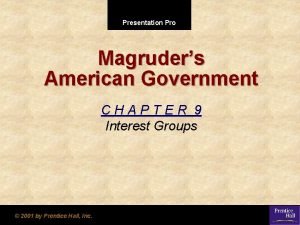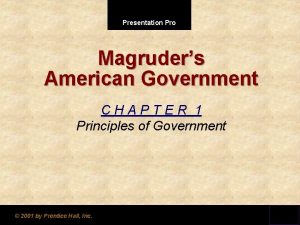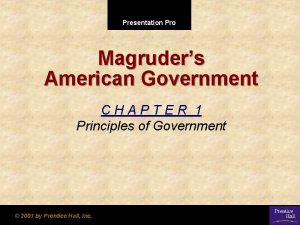Presentation Pro Magruders American Government CHAPTER 3 The















































- Slides: 47

Presentation Pro Magruder’s American Government CHAPTER 3 The Constitution © 2001 by Prentice Hall, Inc.

CHAPTER 3 The Constitution SECTION 1 The Six Basic Principles SECTION 2 Formal Amendment SECTION 3 Informal Amendment Go To Section: 1 2 3 Chapter 3

SECTION 1 The Six Basic Principles • What are the important elements of the Constitution? • What are the six basic principles of the Constitution? Go To Section: 1 2 3 Chapter 3, Section 1

Constitution “the Supreme Law of the Land” Highest form of law in the United States Go To Section: 1 2 3

An Outline of the Constitution Ø 7, 000 words ØFew details ØOrganized in a simple straightforward way. ØTells the way: Ø that the federal government is organized, Øhow the leaders are selected, Øthe procedures they must follow as they perform their duties, Øsets the limits within which government can operate. ØOutlines how politics run… helps determine who wins and loses Go To Section: 1 2 3

How the constitution is divided ØPreamble: states the purpose of the Constitution Ø 7 Articles • #1 Creates the Legislative Branch • #2 Creates the Executive Branch • #3 Creates the Judicial Branch • #4 Relations among the States • #5 Process of Amending the Constitution • #6 National debts; constitution as supremacy of national law, and oaths of office • #7 Ratifying the Constitution Ø 27 Amendments ØFirst ten are called “The Bill of Rights” Go To Section: 1 2 3

6 principles of the Constitution • The constitution is built around 6 basic principles 1. Popular sovereignty 2. Limited government 3. Separation of powers 4. Checks and balances 5. Judicial review 6. Federalism Go To Section: 1 2 3

#1 POPULAR SOVEREIGNTY • People are the ONLY source of any and all government power • Government can exist only with the consent of the government [approval of the people] • That’s why it starts with: “We the people of the United States…do ordain and establish this Constitution of the United States of America. ” • People give the government power through the Constitution -----> government exercises powers through the elected leaders that are chosen by the people to represent them. Go To Section: 1 2 3

How does this cartoon show popular sovereignty? Go To Section: 1 2 3

#2 LIMITED GOVERNMENT • • No government is all-powerful • Government must obey the law- called constitutionalism… government must be conducted according to constitutional principles Government is restricted in what it may do and it can only do those things that the people have given it the power to do Øalso known as rule of the law… meaning that government and its officers are always subject to, and never above, the law. • Each individual has rights that government cannot take away. Go To Section: 1 2 3

How does this cartoon show limited government? Go To Section: 1 2 3

#3 SEPERATION OF POWERS • Principle in which the executive, legislative, and judicial branches of government are three independent and coequal branches of government. • We divide up the power between Congress [the legislative], the President [the executive], and the courts [the judicial] ØEach branch has its own article that outlines their duties ØLegislative: they make the laws ØExecutive: law-executing, law-enforcing, lawadministering ØJudicial: interpret and apply the laws in cases brought before them Go To Section: 1 2 3

Go To Section: 1 2 3

How does this cartoon show separation of powers? Go To Section: 1 2 3

#4 CHECKS AND BALANCES • System that allows the legislative, executive, and judicial branches to check, or restrain, the actions of one another Go To Section: 1 2 3

Go To Section: 1 2 3

How does this cartoon show checks and balances? Go To Section: 1 2 3

#5 JUDICIAL REVIEW • Consists of the power of a court to determine the constitutionality of a governmental action. ØIf the courts declare something as unconstitutionalthey’re saying its illegal, null and void, or no force or effect…meaning that government action is violating the constitution • Talked about my Alexander Hamilton in The Federalist Papers • In a famous court case; Marbury v. Madison 1803 - Supreme court established power of judicial review • Since 1803… Supreme court has found 150 cases in which an act of part of an act of Congress was unconstitutional Go To Section: 1 2 3

How does this cartoon show judicial review? Go To Section: 1 2 3

#6 FEDERALISM • A system of government in which the powers of government are divided between a central government and several local governments • Power is divided between the federal government and then between the 50 states because they wanted to limit the power of the central government Ø Framers of the constitution were convinced that 1. Governmental power poses a threat to individual liberty 2. So exercise of governmental power needs to be restrained 3. So divided governmental power is to prevent abuse of power Go To Section: 1 2 3

How power is divided Go To Section: 1 2 3

How does this cartoon show federalism? Go To Section: 1 2 3

Section 1 Review 1. Which of the following principles includes the power of the courts to determine whether a governmental action is constitutional or not? (a) Checks and balances (b) Judicial Review (c) Separation of Powers (d) Federalism 2. The principle of popular sovereignty asserts that the (a) government should be divided into three branches. (b) monarch is the supreme ruler. (c) means of production should be owned by the proletariat. (d) people are the source of any and all government power. Want to connect to the Magruder’s link for this section? Click Here! Go To Section: 1 2 3 Chapter 3, Section 1

SECTION 2 Formal Amendment • What are the different ways to formally amend, or change the wording of, the Constitution? • How many times has the Constitution been amended? • What is the Bill of Rights? Go To Section: 1 2 3 Chapter 3, Section 2

Changes in America Through Time • 1789: • Four million people scattered over 1, 300 miles of the Eastern border • Agricultural nation • 13 states • Transportation via horseback and sailing ships • 2012 • Over 300 million people across whole continent • Most powerful nation • Highly industrialized/technological • 50 states Go To Section: 1 2 3

Durability of the Constitution How has the Constitution, written in 1789, endure and kept pace with these changes and growth? • Answer: v. Constitution of today is the same as that of 1789…. Same words, same meanings…. Just some new words have been added………. . v. The process of constitutional change, of modification and growth, happens in one of two ways: 1. Formal amendment 2. Informal means Go To Section: 1 2 3

Amending the Constitution • The Constitution provides for its own amendment—that is, for changes in its written words…it explain how to make changes to itself • Article V sets out two methods for the proposal and two methods for the ratification of constitutional amendments, creating four possible methods of formal amendment. Go To Section: 1 2 3 Chapter 3, Section 2

Formal Amendment • Formal Amendment is the changes or additions that become part of the written language of the Constitution itself • Framers didn’t want to make it easy to change the constitution- So they came up with four hard ways to do it. Go To Section: 1 2 3

Formal Amendment Process • The four different ways by which amendments may be added to the Constitution are shown here: Go To Section: 1 2 3 Chapter 3, Section 2

METHOD #1 • Proposed by two- thirds vote of each house of Congress • Ratified by three fourths of State Legislatures Go To Section: 1 2 3

METHOD #2 • Proposed by two-thirds vote of each house of Congress • Ratified by conventions in three-fourths of states Go To Section: 1 2 3

METHOD #3 • Proposed by national convention called by Congress at request of two thirds of state legislatures • Ratified by threefourths of state legislatures Go To Section: 1 2 3

METHOD #4 • Proposed by national convention called by Congress at request of two thirds of state legislatures • Ratified by conventions in three fourths of states Go To Section: 1 2 3

Formal Amendment Process Highlights Constitutional Principles • Formal Amendment process works on two basic principles of the Constitution: 1. Federalism v. Proposal always takes place at the national level v. Ratification always takes place at the state level 2. Popular Sovereignty v. When an amendment is proposed, its voted on by the people… so the action represents the expression of the people’s sovereign will! Go To Section: 1 2 3

Some were a FLOP! • Since 1789, 15, 000 resolutions for amendments have been sent to Congress…. Only 33 passed votes in the two houses and made it to State legislatures… of those, only 27 passed! • Some that were proposed, and didn’t pass…. 1810: Voided citizenship of anyone who had any foreign title or honor. 1789: Distribution of seats in the House of Representatives 1861: Prohibited forever any 1972: Equal Rights of amendment relating to Women [ERA] to give slavery equality of rights 1924: Give Congress under the law to power to regulate 1978: Give District of women child labor Columbia Seats in Congress Go To Section: 1 2 3

Amendments to the Constitution Collectively, the first ten amendments are known as the Bill of Rights. They set out many of our basic freedoms. Go To Section: 1 2 3 Chapter 3, Section 2

Section 2 Review 1. A formal amendment (a) changes the Constitution by passing laws. (b) changes the written language of the Constitution itself. (c) allows States to secede from the United States. (d) none of the above. 2. Many of the basic rights of citizens are constitutionally guaranteed in (a) English common law. (b) the Declaration of Independence. (c) the Magna Carta. (d) the Bill of Rights. Want to connect to the Magruder’s link for this section? Click Here! Go To Section: 1 2 3 Chapter 3, Section 2

SECTION 3 Informal Amendment • How has basic legislation changed the Constitution over time? • What powers do the executive branch and the courts have to amend the Constitution? • What role do party politics and custom have in shaping the Federal Government? Go To Section: 1 2 3 Chapter 3, Section 3

• Many changes and interpretations have been made to the Constitution that have not involved any changed in its written words Go To Section: 1 2 3

Informal Amendment Processes Informal amendment is the process by which over time many changes have been made in the Constitution which have not involved any changes in its written word. The informal amendment process can take place by: (1) The passage of basic legislation by Congress; (2) Actions taken by the President; (3) Key decisions of the Supreme Court; (4) The activities of political parties; and (5) Custom and usage Go To Section: 1 2 3 Chapter 3, Section 3

#1 Basic legislation by Congress: 2 ways 1) Passed laws that clarify several of the Constitution’s brief provisions Ex: Article III, Section I only talks about having a Supreme Court and “such inferior courts a the Congress may from time to time ordain and establish”…. Congress passed the Judiciary Act in 1789 ad since then, has created all the federal courts…. 2) Congress has added to the Constitution by the way in which it has used many of its powers Ex: Constitution says that Congress has the power to “regulate foreign and interstate commerce. ”…Congress has passed thousands of laws about this so that they expanded the words of the Constitution Go To Section: 1 2 3

#2 Executive Action • Presidential actions such as the use of the military under the power of commander in chief. • Presidents add on to “executive power” based on what they think it means…. Thomas Jefferson took it to mean he can buy more land for the U. S. with the Louisiana Purchase in 1803, even though the Constitution doesn’t say he could • An executive agreement is a pact made by the President directly with the head of a foreign state and they do not need to be approved by Senate… • A treaty is a formal agreement between two or more sovereign states that needs to be approved by Senate Go To Section: 1 2 3

#3 Court Decisions • The nation’s courts, most importantly the United States Supreme Court, interpret and apply the Constitution in many cases they hear. Go To Section: 1 2 3

#4 Party Practices • • No mention of parties in the Constitution Ex: No method for nominating a person for the presidency • Since 1830 s, parties have held national conventions to do that • Changed the purpose of the electoral college • Congress conducts its business on the basis of parties • President makes appointments to office based on parties Go To Section: 1 2 3

#5 Custom and Usage • Custom: A traditional and widely accepted way of behaving or doing something that is specific to a particular society, place, or time. • Examples: • Heads of the 15 executive departments make up the Cabinet • Senate approves the presidential appointments who are acceptable to the senator or senators of the President’s party from the State involved • “No-third term tradition” was started by George Washington and followed for over 150 years until 1940 and 1944 when President Roosevelt won a third and fourth term…so they added the 22 nd Amendment limiting the President to two terms only Go To Section: 1 2 3 Chapter 3, Section 3

Section 3 Review 1. Name two of the five methods by which we can informally amend the Constitution. 2. Define “executive agreement”. Want to connect to the Magruder’s link for this section? Click Here! Go To Section: 1 2 3 Chapter 3, Section 3

• • What is the difference between an executive agreement and a treaty Define what we mean by basic legislation Define what we mean by executive action Define what we mean by court decisions Define what we mean by party practices Define what we mean by custom and usage Give an example of _______ Go To Section: 1 2 3
 Magruders
Magruders Chapter 2 american government
Chapter 2 american government Origins of american government vocabulary
Origins of american government vocabulary Chapter 2 origins of american government answer key
Chapter 2 origins of american government answer key Chapter 2 origins of american government worksheet answers
Chapter 2 origins of american government worksheet answers Chapter 2 lesson 1 government in colonial america
Chapter 2 lesson 1 government in colonial america Chapter 2 origins of american government
Chapter 2 origins of american government American government chapter 4
American government chapter 4 Macro pro
Macro pro National powers
National powers Origins of american government section 4
Origins of american government section 4 Unit 1 government study guide
Unit 1 government study guide Unit 1 foundations of american government
Unit 1 foundations of american government Origins of american government section 1
Origins of american government section 1 Foundations of american government unit test
Foundations of american government unit test Origins of american government section 1
Origins of american government section 1 Six purposes of government
Six purposes of government American dream powerpoint presentation
American dream powerpoint presentation Hình ảnh bộ gõ cơ thể búng tay
Hình ảnh bộ gõ cơ thể búng tay Frameset trong html5
Frameset trong html5 Bổ thể
Bổ thể Tỉ lệ cơ thể trẻ em
Tỉ lệ cơ thể trẻ em Gấu đi như thế nào
Gấu đi như thế nào Tư thế worms-breton
Tư thế worms-breton Bài hát chúa yêu trần thế alleluia
Bài hát chúa yêu trần thế alleluia Môn thể thao bắt đầu bằng từ chạy
Môn thể thao bắt đầu bằng từ chạy Thế nào là hệ số cao nhất
Thế nào là hệ số cao nhất Các châu lục và đại dương trên thế giới
Các châu lục và đại dương trên thế giới Công thức tiính động năng
Công thức tiính động năng Trời xanh đây là của chúng ta thể thơ
Trời xanh đây là của chúng ta thể thơ Mật thư anh em như thể tay chân
Mật thư anh em như thể tay chân Làm thế nào để 102-1=99
Làm thế nào để 102-1=99 Phản ứng thế ankan
Phản ứng thế ankan Các châu lục và đại dương trên thế giới
Các châu lục và đại dương trên thế giới Thể thơ truyền thống
Thể thơ truyền thống Quá trình desamine hóa có thể tạo ra
Quá trình desamine hóa có thể tạo ra Một số thể thơ truyền thống
Một số thể thơ truyền thống Cái miệng xinh xinh thế chỉ nói điều hay thôi
Cái miệng xinh xinh thế chỉ nói điều hay thôi Vẽ hình chiếu vuông góc của vật thể sau
Vẽ hình chiếu vuông góc của vật thể sau Biện pháp chống mỏi cơ
Biện pháp chống mỏi cơ đặc điểm cơ thể của người tối cổ
đặc điểm cơ thể của người tối cổ Ví dụ giọng cùng tên
Ví dụ giọng cùng tên Vẽ hình chiếu đứng bằng cạnh của vật thể
Vẽ hình chiếu đứng bằng cạnh của vật thể Vẽ hình chiếu vuông góc của vật thể sau
Vẽ hình chiếu vuông góc của vật thể sau Thẻ vin
Thẻ vin đại từ thay thế
đại từ thay thế điện thế nghỉ
điện thế nghỉ Tư thế ngồi viết
Tư thế ngồi viết

